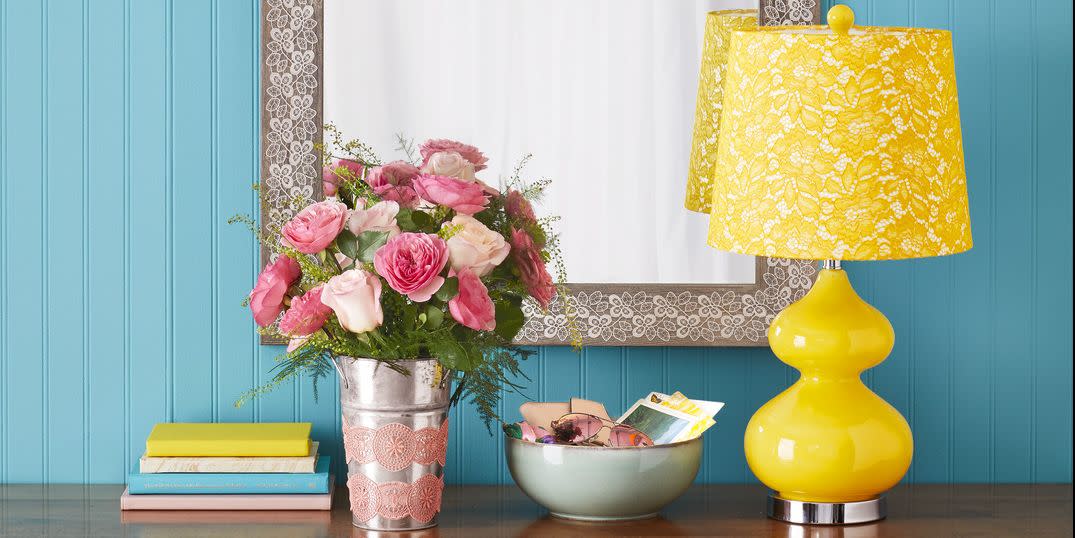How to Paint a Room Like a Pro

Home DIY projects can be intimidating, and the bigger they are, the more they can weigh on you. It's easy to understand why people hire pros for things, but some tasks are easier to DIY than you think. Learning how to paint a room is one of those jobs that seems daunting but is totally doable if you read up, prep, and put your mind to it. You should definitely give it a chance, because painting is one of the easiest (and cheapest) ways to completely make over a room. And after spending so much time at home, isn't everyone desperate to refresh their space?
Ree Drummond is admittedly not a huge DIYer, but she does love color and giving a room a splash of something unexpected. She decided to go with a matte, almost-black chalkboard paint when she painted the walls of The Lodge pantry, and she loved the result. "The walls are covered in chalkboard paint, which I thought would be fun for doodling. Turns out, the dark color was just what the space needed," she says.
If you're looking for your own change-up, painting a room is the way to go. Read on to learn about what materials, tips, and tricks you'll need to paint a room worthy of Instagramming.
Plan Your Project
First off: Are you painting a statement wall or a whole room? Does the ceiling need to be painted or the trim? Make a list of what needs to be done, so you can figure out how much paint you need, as well as how long it will take you to complete the task.
Pick a Color and Finish
Paint typically comes in a variety of finishes including (from shiniest to most matte) high gloss, semi-gloss, satin, eggshell, and matte. In spaces prone to moisture like kitchens or bathrooms, you'll want to use a glossier paint, which stands up to humidity better. Eggshell is the most common finish to use in other rooms of the house— it has a bit of a sheen but is pretty flat overall. Before you commit to a paint color, paint a swatch of it on your wall and see how the paint color looks during the day and the night to make sure you like it.
Purchase Your Paint
If you're making a drastic color change or painting damaged walls, you'll need to purchase a primer. Some paints are paint and primer in one, so make sure to check if the color you select comes with this option. Next, it's time to figure out how many cans to get. Many paint websites have their own calculators, but if you're going to do it manually, Clare Paint founder Nicole Gibbons has a way: "To get started, multiply the width times the height of each wall in your space and voila, you've got your square footage," she says. Just make sure to calculate the square footage of any window or door you won't be painting and subtract that from your total square feet.
Grab Your Supplies
Yes, you'll need paint, but you'll also need a variety of other items. See this checklist below and stock up!
Spackle
Sandpaper
Painter's Tape
Paint Brushes (angled and straight to get into corners)
Paint Tray
Paint Roller
Stir Stick
Drop Cloth
Prep Your Walls
Wipe your walls down with a sponge and hot water to remove any dust or grime.
Spackle any holes or gaps in the wall and let dry.
Start sanding: If there are any uneven surfaces or chipped paint spots, sand them down to create a smooth surface for the paint. If your walls are good to go, skip this step.
Wipe away any excess debris.
Prime Time
Primer in some form is essential for any painting job: It smooths out imperfections and creates an even layer for your paint color to go on top of. If you're painting with a light color over a light color, one coat is more than enough, but if you're painting a light color on a dark-colored wall, you'll need at least two layers of the stuff. Remember: Some paints are paint and primer in one! They typically cost a bit more up front but save you from buying primer separately, so in the long term, they're usually cost effective.
Get Taping
Before you dip your brush, pick up your painter's tape. Start at a corner and work your way across the wall and tape around the perimeter of the space you plan to paint. Press down on the tape thoroughly to make sure the edges are perfectly adhered to the wall.
Now, Paint!
Benjamin Moore notes that moisture in the air can keep paint from drying, so pick a dry day to start your project. Use the stirring stick to mix your paint, then pour a thin layer of paint in your tray (it should fill about one-quarter of the tray). Dip your roller into the paint, gently tap off any excess, and apply to the wall in an overlapping "W" pattern until the wall is covered. Let the first coat dry before painting a second.

